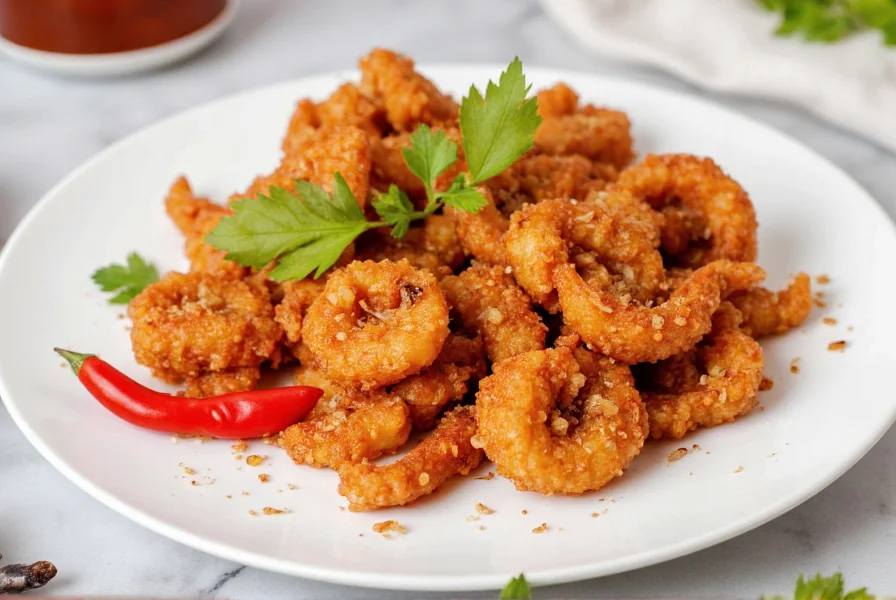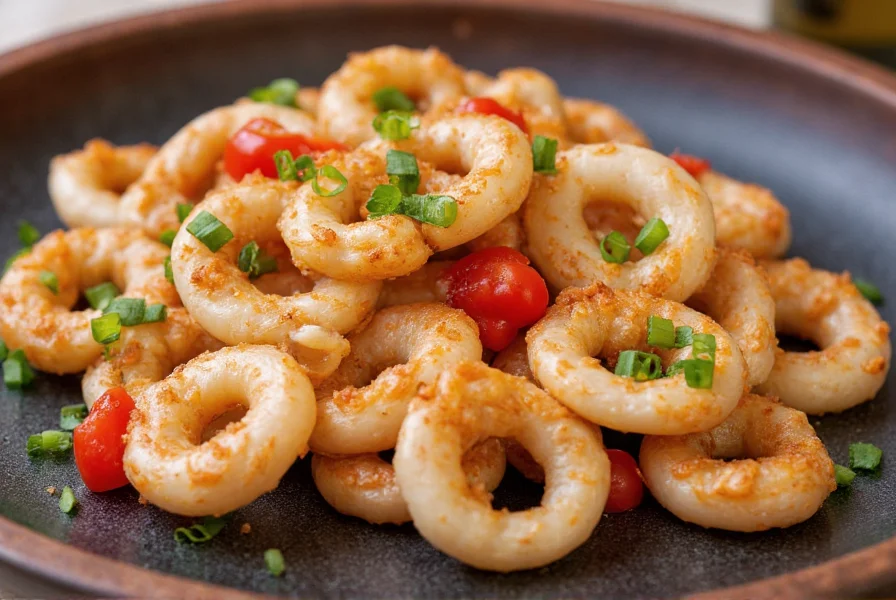Salt and pepper chilli squid represents one of the most beloved seafood preparations in Chinese cuisine, particularly within Cantonese cooking traditions. The dish transforms humble squid into an extraordinary culinary experience through precise preparation techniques and a carefully balanced spice mix. Understanding what makes this dish special requires examining both its components and preparation methodology.
The Essential Components of Authentic Salt and Pepper Chilli Squid
The magic of salt and pepper chilli squid lies in its deceptively simple ingredient list. Fresh squid forms the foundation, typically cleaned and cut into bite-sized rings or scored pieces that maximize surface area for the flavorful coating. The signature seasoning blend combines coarse sea salt, freshly cracked black pepper, and dried red chillies that provide gentle heat without overwhelming the delicate seafood flavor.
Additional elements create the dish's aromatic complexity:
- Fresh garlic, thinly sliced or minced
- Shallots or spring onions for sweetness
- Cornstarch batter for achieving perfect crispness
- Szechuan peppercorns (in some regional variations)

Preparation Technique: The Secret to Perfect Texture
Professional chefs achieve the distinctive texture of salt and pepper chilli squid through a two-step cooking process. First, the squid undergoes a quick flash-fry at high temperature (typically 375°F/190°C) to create an ultra-crisp exterior while maintaining tender interior texture. This initial fry usually lasts only 60-90 seconds to prevent rubberiness.
The second stage involves stir-frying the pre-cooked squid with the aromatic spice mixture. This technique allows the flavors to adhere to the crispy surface without compromising texture. Many restaurants use a double-fry method where squid is fried once, rested, then fried again briefly before the final toss with seasonings—this ensures maximum crispness that withstands the stir-frying process.
Regional Variations Across Chinese Cuisine
While originating in Cantonese cooking, salt and pepper chilli squid has evolved with regional interpretations:
| Regional Style | Distinctive Features | Additional Ingredients |
|---|---|---|
| Cantonese (Original) | Moderate heat, emphasis on clean squid flavor | White pepper, minimal sauce |
| Szechuan Style | Bolder heat, numbing sensation | Szechuan peppercorns, more dried chillies |
| Hong Kong Cafe Style | Slightly sweeter profile | 少许糖 (small sugar amount), more garlic |
| Singaporean Interpretation | Coconut milk influence | Light coconut milk base, curry leaves |
Serving Traditions and Pairing Recommendations
Salt and pepper chilli squid traditionally appears as a shared appetizer or main course in Chinese dining. The dish pairs exceptionally well with steamed jasmine rice that absorbs the flavorful seasonings. Many diners enjoy squeezing fresh lime over the squid just before eating, which brightens the rich flavors.
For beverage pairings, consider:
- Crisp lagers or pilsners that cut through the richness
- Dry Riesling or unoaked Chardonnay for wine drinkers
- Hot oolong tea to cleanse the palate between bites
When ordering salt and pepper chilli squid at restaurants, look for establishments that prepare it to order rather than keeping pre-fried squid waiting. The best versions maintain crispness for at least 15-20 minutes after preparation—any dish that becomes soggy immediately likely used improper batter or oil temperature.
Common Misconceptions About the Dish
Many people confuse salt and pepper chilli squid with similar preparations. It differs significantly from:
- Chilli squid - Typically features a sweeter, saucier preparation with more pronounced tomato elements
- Pepper squid - Usually lacks the chilli component and may use different pepper varieties
- Salt and pepper chicken - While using similar seasoning, the cooking technique differs for poultry
The authentic preparation should showcase the squid's natural sweetness enhanced by, not overwhelmed by, the seasonings. Properly executed salt and pepper chilli squid delivers multiple textural experiences in each bite—the initial crunch giving way to tender squid with aromatic spices clinging to every surface.
How to Properly Enjoy Salt and Pepper Chilli Squid
To fully appreciate this dish, follow these serving and eating guidelines:
- Consume immediately after preparation while maintaining optimal crispness
- Eat with both chopsticks and a small spoon for rice
- Begin with smaller pieces to experience the flavor balance
- Squeeze fresh lime over portions just before eating
- Balance each bite with rice to moderate the spice level
- Drink something cool between bites to refresh your palate

Frequently Asked Questions
What makes salt and pepper chilli squid different from regular chilli squid?
Salt and pepper chilli squid features a dry spice coating of coarse salt and freshly cracked black pepper applied after frying, creating a crispy exterior with distinct seasoning. Regular chilli squid typically uses a wet sauce preparation with tomato elements and sugar, resulting in a saucier dish with different flavor profile.
Is salt and pepper chilli squid supposed to be very spicy?
Traditional salt and pepper chilli squid offers moderate heat from dried red chillies that complements rather than overwhelms the dish. The primary flavors are savory from the salt and aromatic from the black pepper, with chilli providing background warmth. Authentic versions shouldn't be excessively spicy, allowing the natural sweetness of fresh squid to shine through.
What's the best way to reheat leftover salt and pepper chilli squid?
For optimal results, reheat salt and pepper chilli squid in an air fryer at 350°F (175°C) for 3-4 minutes rather than using a microwave. This restores crispness without making the squid rubbery. Avoid adding moisture during reheating, as this will compromise the delicate texture that defines the dish.
Can I make salt and pepper chilli squid with frozen squid?
While fresh squid produces superior results, you can use frozen squid if properly thawed and dried. Thaw squid overnight in the refrigerator, then pat thoroughly dry with paper towels. For best texture, soak thawed squid in milk for 30 minutes before cooking to reduce any potential fishiness from frozen product.
Why does my homemade salt and pepper chilli squid turn out rubbery?
Rubbery texture typically results from overcooking or improper oil temperature. Squid requires extremely brief frying—60-90 seconds at 375°F (190°C). If oil isn't hot enough, squid releases moisture and becomes tough. Always dry squid thoroughly before battering, and consider a double-fry technique: initial quick fry, rest, then final brief fry before tossing with seasonings.











 浙公网安备
33010002000092号
浙公网安备
33010002000092号 浙B2-20120091-4
浙B2-20120091-4